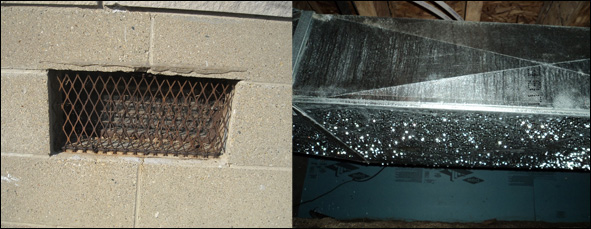
One of the major fallacies about venting a crawlspace is that ventilation will reduce the crawlspace moisture levels. In reality, venting a crawl space to remove moisture only works when the outside air is dryer than the crawl space air. By “dryer” we do not just mean a lower relative humidity, but also a lower absolute humidity level.
When we say relative humidity we mean how full of water the air is relative to the maximum amount of water it can hold at a given temperature. Absolute humidity is the amount of moisture in an amount of air.
On a hot summer day, we might have a temperature of 82 degrees and a relative humidity of 70%. If the temperature of the crawlspace is 62 degrees, what happens when we bring in this humid 82 degree air?
For every one degree the air is cooled, the relative humidity goes up by 2.2%, because cool air holds less water than warm air. When looking at our situation, the difference between the outside air we let in at 82 degrees, and the crawl space at 62 degrees, is 20 degrees. 20 degrees multiplied by 2.2% is a 44% increase in relative humidity.
Our 82 degree air began with 70% relative humidity; in other words, at 82 degrees it was 70% full of the water it can hold at that temperature. When the air is brought into 62 degree environment, it increases the relative humidity by 44%. That’s technically 114% relative humidity which is impossible because at 100% relative humidity, the air cannot hold any more water and must give up its moisture in the form of a liquid……………..condensation.
Crawlspace Venting Causes Condensation.
During the 80 and 90 degree days of summer, the outside air is very humid. The crawlspace temperature maintains a temperature of 55 – 65 degrees because of the earth’s soil and the AC system leaking. When this hot, humid air is vented into the cooler crawlspace environment, the colder surfaces in the crawlspace will begin to sweat. It is the same concept as taking a glass of ice water outside on a hot summer day. The surface of the glass will immediately begin to condensate.
When a crawlspace is vented on an average summer day, there is going to be condensation on the crawlspace walls, crawlspace floor, air ducts (especially when the AC is on), and cold water pipes. These surfaces are the coldest. During a humid summer day, it is possible for the floor joists, beams, sill plates, and insulation to condensate as well.
Crawlspace Venting Causes Higher Energy Bills.
When your air conditioning travels through your duct system in a vented crawlspace in the summer, the colder air in the ducts is competing against the outside humid air being brought into the crawl space. The air conditioning system has to work harder to compete against this outside air. When the AC system, works harder than it has to, you pay more in electricity. Also, this humid summer air puts a latent load on the HVAC system because the AC system has to work harder to dehumidify this humid air.
In the winter, the vents are “supposed” to be closed to prevent pipes from freezing and to keep the furnace from working harder to heat a house with an extremely cold air leak underneath it. Even when the vents are closed, they are typically not insulated, and will still leak a tremendous amount of cold air into the crawlspace. The freezing cold air that enters a crawlspace is cooling the heat you are pumping through your duct system before it reaches the living space.
Several studies conducted by Advanced Energy, Habitat for Humanity, and Building Science Corp. on the impact of vented crawl spaces on a building’s overall energy efficiency, found that closing crawlspace vents and encapsulating the crawlspace can make a home on average 18% more energy efficient.
Crawlspace Venting Causes Mold Growth.
Another common problem with crawlspace vents and condensation in the summer is the propagation of mold spores. Mold needs between 65% – 70% relative humidity to remain active and produce spores. Summer air can reach 70 – 90 percent relative humidity on any given day. This humid air by itself can lead to an environment conducive to mold growth, especially when this air is reaching the dew point on cooler surfaces in the crawlspace.
Many homeowners spread mulch around their foundations and vents for landscaping purposes. What they do not realize is that mulch contains high levels of mold spores and these spores enter the crawlspace through the vents. The spores are being introduced into a perfect environment for mold growth in the crawl space because they are typically thriving during hot humid summer months when the crawlspace is being vented.
